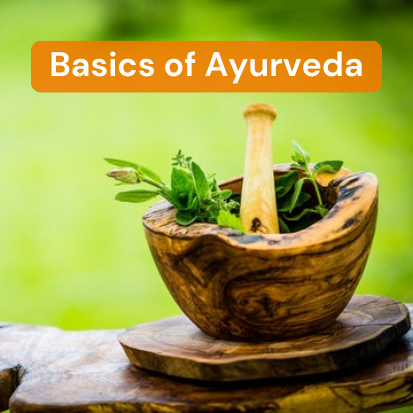Basics of Ayurveda: Ayurveda, often referred to as the “Science of Life,” is an ancient holistic medical practice that originated in India over 5,000 years ago. This ancient therapeutic technique focuses on achieving and maintaining a balanced state of physical, mental, and spiritual well-being.
At the core of Ayurveda, there are three fundamental energies or principles known as doshas. These doshas are Vata, Pitta, and Kapha, and they play a crucial role in understanding one’s constitution and maintaining optimal health. Each individual has a unique combination of these doshas, which determines their physical and physiological characteristics, as well as their vulnerabilities in various health conditions. In this blog, we will explore the basics of Ayurveda, with a focus on these three doshas.
Basics of Ayurveda:
What Are Doshas?
According to Ayurveda, everything in the universe, including our bodies, is made up of five elements: Earth, Water, Fire, Air, and Ether (space). These elements combine to form the three doshas, and each dosha represents a unique combination of these elements.
Vata Dosha: The Energy of Movement
Qualities of Vata:
- Elements: Air and Ether
- Qualities: Light, dry, cold, rough, delicate, erratic, and clear.
Characteristics of Vata:
- Vata is responsible for all movement in the body, including blood flow, muscle movements, and nerve impulse transmission.
- It governs communication-related body activities such as speech and sensory perception.
- Vata influences creativity, excitement, and adaptability.
Balanced Vata:
- When Vata is in balance, an individual is energetic, creative, and adaptable.
- They have a healthy digestive system, regular evacuation, and a clear mind.
Imbalanced Vata:
- An excess of Vata can result in feelings of anxiety, restlessness, and digestive disturbances.
- Physical symptoms may include dry skin, constipation, and joint pain.
Pitta Dosha: The Energy of Transformation
Qualities of Pitta:
- Elements: Fire and Water
- Qualities: Hot, sharp, intense, oily, and light
Characteristics of Pitta:
- Pitta is responsible for digestion and metabolism in the body.
- It governs body temperature, intelligence, and courage.
- Pitta is associated with ambition, leadership, and a sharp intellect.
Balanced Pitta:
- When Pitta is in balance, an individual is intelligent, confident, and has a strong digestion.
- They have a warm body temperature and healthy skin.
Imbalanced Pitta:
- Imbalanced Pitta can lead to anger, irritability, and inflammation.
- Physical symptoms may include heartburn, skin rashes, and excessive sweating.
Kapha Dosha: The Energy of Stability
Qualities of Kapha:
- Elements: Earth and Water
- Qualities: Heavy, cold, slow, oily, smooth, dense, soft, and static.
Characteristics of Kapha:
- Kapha plays a vital role in providing body stability and structure
- It governs qualities like love, compassion, and forgiveness.
- Kapha provides lubrication to joints and organs and helps maintain immune function.
Balanced Kapha:
- When Kapha is in balance, an individual is loving, calm, and has strong endurance.
- They have well-lubricated joints and healthy, radiant skin.
Imbalanced Kapha:
- Imbalanced Kapha can lead to lethargy, attachment, and weight gain.
- Physical symptoms may include congestion, excessive mucus, and sluggish digestion.
Understanding Your Dosha
In Ayurveda, every individual has a unique constitution known as “Prakriti.” This constitution is determined by the predominant dosha or doshas in one’s body. Understanding your Prakriti is essential for maintaining balance and preventing illness. Here’s a brief overview of how to identify your primary dosha:
Vata Dominant:
- If you are naturally lean, have a slim body, and tend to be more energetic and creative, you may have a Vata-dominant constitution.
- Vata individuals are prone to imbalances related to anxiety, irregular digestion, and insomnia when out of balance.
Pitta Dominant:
- If you have a medium build, a strong appetite, and are highly focused and ambitious, you may have a Pitta-dominant constitution.
- Pitta individuals are susceptible to imbalances related to anger, acidity, and skin issues when out of balance.
Kapha Dominant:
- If you have a sturdy build, good endurance, and a calm and compassionate nature, you may have a Kapha-dominant constitution.
- When out of balance, Kapha persons are prone to weight gain, lethargy, and congestion.
It’s important to note that most people have a combination of doshas in varying proportions, and this combination is unique to each individual. Understanding your Prakriti can help you make lifestyle and dietary choices that support your natural constitution and maintain balance.
Balancing the Doshas
Ayurveda focuses on maintaining or restoring balance among the doshas to promote health and well-being. Below, you will find some key recommendations for balancing each dosha:
Balancing Vata:
- Diet: Eat warm, nourishing foods and avoid excessive cold or raw foods.
- Lifestyle: Establish a routine, practice mindfulness, and ensure you get enough rest.
- Exercise: Engage in gentle, grounding activities like yoga and walking.
Balancing Pitta:
- Diet: Favor cooling, soothing foods and avoid spicy, hot, and greasy foods.
- Lifestyle: Practice relaxation techniques, manage stress, and avoid excessive competition.
- Exercise: Choose activities that are calming and not overly intense.
Balancing Kapha:
- Diet: Opt for light, warming foods and avoid heavy, oily, and sweet foods.
- Lifestyle: Stay active, engage in regular exercise, and introduce variety into your routine.
- Exercise: Focus on activities that are invigorating and promote circulation.
Conclusion
Ayurveda’s understanding of Vata, Pitta, and Kapha doshas provides a comprehensive outline for assessing and promoting health and wellness. By recognizing your unique constitution and addressing imbalances as they arise, you can take proactive steps to maintain harmony in your mind and body. Ayurveda’s holistic approach encourages not only physical well-being but also mental and spiritual balance, making it a valuable tool for anyone seeking a more holistic approach to health.


